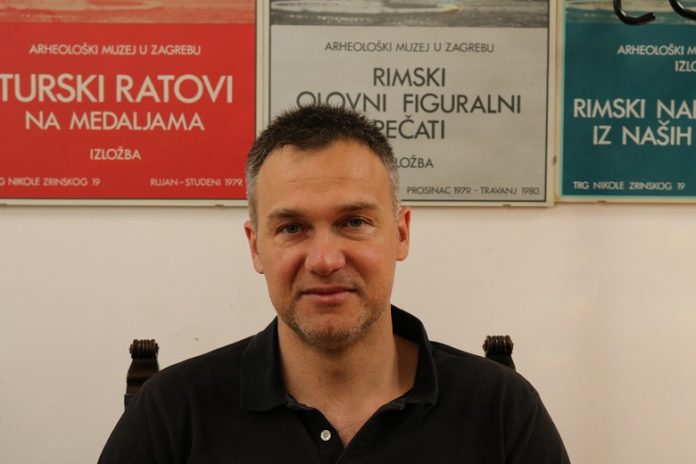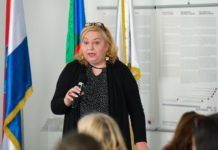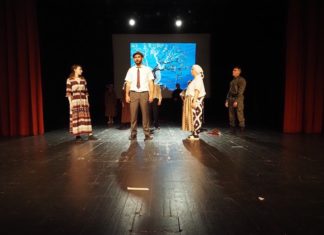How important it is to evaluate, interpret and present certain archaeological site for tourists in order to gain its economic value we can learn best from Sanjin Mihelić, Director of Archaeological Museum in Zagreb and editor of Croatian and English edition of the scientific catalogue “Archaeology and Tourism in Croatia”.
“When it comes to Romani archaeology it is again a topic which is in fact a complete unknown within our framework. Therefore, there is not any, at least for now, set of exploratory questions and plans regarding this segment of wider cultural history in Croatia or wider.”
We have talked to him about the cooperation among the Museum, Croatian Romani Union “KALI SARA” and the City of Zagreb regarding the exhibition “Rromengo drom – A Thousand Years of Roma Migrations”, about whether there is a lack of understanding the value and importance of our own archaeological heritage and about the question of mass tourism in Croatia. The interview was conducted within the premises of the institution which is a direct successor to the oldest museum institution in Zagreb – the National Museum founded in 1836.
You graduated archaeology and Spanish language and literature at the Faculty of Humanities and Social Studies in Zagreb and post-graduated at the University of London. What are the qualities (skills) of an archaeologist?
There are certain basic and specific skills. Basic skills are those which are actually taught at universities or colleges such as the Faculty of Humanities and Social Studies in Zagreb through a three-year program for the acquisition of the archaeologist title, this is certain archaeological methodology, methodology of scientific work and there is also a practice that takes archaeology students to the sites. Field work is important not only for the social imaginary but indeed in the sense of the specific work the archaeologists are dealing with. That is, if not the archaeologist’s equivalent, definitely a fundamental skill.
Likewise, through these first few years, future archaeologists are introduced to the diachronic approach to archaeological periods and certain archaeological topics so that, first of all, if you want to deal with archaeology, you need to acquire a general knowledge base. What happens next and not only through the continuation of the study, but when the archaeologist gets employed, is actually deepening the specific skills.
If we look at what is happening in Croatia, but it is similar to elsewhere in the world, archaeology has a whole range of specialisations within the museum profession. I’m such an example of an archaeologist who has spent his entire working life in the museum so far. But there are archaeologists engaged in the scientific-educational work like archaeologists who continue their career at universities. Besides there are institutes for archaeology and similar and related institutions providing the possibility of subspecialties within the scientific research. Then there are archaeologists whose primary concern is the protection of heritage, etc. There is a very wide range of possibilities.
You are the editor and one of the authors of the scientific catalogue “Archaeology and Tourism in Croatia” and the exhibition of the same name. What is the public feedback and are Croatian citizens interested in history not necessarily related to the 20th century?
It is about the topic that in a certain way represents selected area of my professional interests. I believe that archaeology and tourism are in a way natural partners although this partnership in a practical sense is not always as effective as we would like it to be. For Croatia, possessing extremely rich archaeological heritage and developed tourism, it represents a quality partnership, indispensable and logical step which might, if managed properly, lead to the whole series of positive effects both for archaeology and for tourism as well as for the whole range of other stakeholders, including the public, wider and selected, but others as well, such as local communities, private and public sector, etc.
When it comes to the Croatian public interest for topics related closely to the archaeology framework, I can say that it is well expressed. Certainly, this interest partly arises from the fact that Croatia is extremely rich in archaeological findings and sites form the whole range of history periods. There is scarcely any archaeological period not represented, at least somewhere in Croatia – from the early Prehistoric age to the Ancient History, Classical Antiquity is extremely rich, especially the Ancient Rome phase but also Middle Ages, Early, High and Late Middle Ages, Early Modern Period and Late Modern Period, and so on. Really, wherever you go in Croatia you will come upon more or less clear and attractive sign of a certain time period meaning that we have much to offer, but not only to tourist but to ourselves in the first place. What Archaeological Museum in Zagreb and its sister institutions have been doing is fostering our heritage and communicating its value to the wider public.

We have seen that some internationally famous TV series, such as Game of Thrones and Star Wars, were made on the sites important for Croatian history and heritage. They represent an excellent marketing for Croatia and we could call it a free marketing, but is it also a burden for the very City of Dubrovnik being overcrowded with tourists? Does Croatia need a mass tourism?
It is a pretty complex question because it is a fact that popular TV series like Game of Thrones and SF series like Star Wars in a certain way draw an additional attention to Croatia, in this specific case to Dubrovnik which is per se a free marketing. It is a certain kind of niche, however a niche which can be described, as you mentioned yourself, in mass numbers. It is absolutely questionable whether Dubrovnik needs any marketing at all since it has stepped into a phase, a long time ago, where the primary focus is actually on protection and conservation of this complex asset. We should not forget that this City was among the first sites to have been included on the UNESCO World Heritage List but it is also the City that has been going through the same process like some other destinations like Venice, Amsterdam and lately Barcelona, and that is increased interest on a global level which leads to a significant decrease of life quality for local population and wider society as well.
Venice has been recognised on a global level as an impressive negative example leading to the complete desolation of the historic town centre. So it is a mass immigration of local population, it is a gentrification of these areas where housing units are turned into something exclusively dedicated to tourism and finally we talk about the ghost towns.
Of course, here is not about the dire prophecy wishing to affect Dubrovnik in any way, but the fact is that there is a trend where the very town centre, by loosing its population and with its prices of life, has not been adjusting to its local and national level but to the global market. It is impossible to have coffee in the historic town centre at a price corresponding other parts of Croatia because these prices correspond the levels of world destinations. These are processes and driving forces which are at a convergence point, idea, not necessarily consciously shaped, but certainly an idea that this is a destination coming much closer to an unambiguity – it is becoming a destination, not a place to live in. This is, of course, something we cannot welcome. When it comes to the heritage sector and what Archaeological Museum in Zagreb has been doing is definitely about heritage conservation and its promotion and popularisation, however always in terms of viability measures. There are also numerous examples of more positive processes but this process that we have been talking about here is the process hiding a lot of dangers for our heritage and there are people standing behind it, people who should be our priority.
What can you tell us about current archaeological explorations in Croatia?
There are several hundreds archaeological explorations every year in Croatia. When we talk about explorations it is necessary to make distinction between two major components. There are systematic and protection explorations. Protection explorations are a kind of exploration conducted in situations when the site is endangered due to construction of housing units, shopping malls, infrastructure, roads, pipelines, etc. Since there has constantly been construction of every kind throughout Croatia, very often during the construction they encounter archaeological heritage. It is stipulated by the law and the practice is committed, that the archaeological heritage has to be protected before construction. This protection does not mean that construction will be forbidden on the site since archaeological heritage has been discovered, but the protection exploration will be done meaning that in a relatively short period of time the site will be explored, everything will be documented and recorded, findings will be collected and stored in a local or any other museum designated as depository and later there will be building or a road there. So these are the protection explorations although it sounds paradoxically since it is actually about destruction because the site will be more or less destructed. Such explorations are the majority of cases since, as I have already said, every time they construct something on an archaeological site, the exploration must be conducted. Its purpose is not answering some scientific questions or some specific idea which should be verified through archaeology, but exclusively protection.
Another kind of explorations is systematic where an element of each scientific research project whether as an idea or an element of a presentation is a wish to physically present the heritage on the very sites or something else that a museum or any other archaeological institution would like to prove. It is a multi annual kind of exploration that our public is mostly familiar with, such as Vučedol explorations and some other, less known sites. These explorations are not aimed to protect anything but to get as many data as possible, to get answers to targeted questions posed consciously through a long-term, long-lasting, meticulous work, and whenever possible actuate this site making it valuable for the local community, tourism and similar. Therefore, protection explorations very nearly reach out to the public eye and ear, only in the situation when it is about an extraordinary discovery they can get a little bit more information about it. Several years ago, let me just mention, it was about the silver from Cibal, in Vinkovci, a town that lies upon a whole series of towns and throughout history, ever since the Neolithic and other Prehistoric age periods, finally through Ancient Rome period represented a big and important Ancient Rome town where two Roman emperors were born. It is impossible to start digging in Vinkovci without finding some archaeology. It is the same case with some other sites and towns both of continental and coastal Croatia where numerous today’s towns follow the continuity dating most often from the very Prehistoric Age and definitely from Classical Antiquity all the way to High Middle Age.
Therefore, I repeat, systematic explorations reach out to the public more often, like the ones in Vučedol or for example Kaptol and sites closer to Zagreb like Andautonija, that is Ščitarjevo, Varaždinske toplice… These sites have been continuously and systematically explored for decades and the results are then clearly visible.

Archaeological Museum staged the exhibition „Rromengo drom – A Thousand Years of Roma Migrations“. How was this cooperation between the Museum and Croatian Romani Union „KALI SARA“ together with Veljko Kajtazi, MP, arranged?
First of all, I would not like to loose any opportunity to express my satisfaction for not only fruitful cooperation but also for the excellent results and reception that the “Rromengo drom” exhibition had. It is the situation when some very nice facts coincided, above all open approach and wish to cooperate. Archaeological Museum has recognised the importance of the Romani topic since it has not been sufficiently represented in the Croatian public and culture. It is about the people and social population who have quite a lot to say and show and we were interested in assisting this story, which is not only interesting but overwhelming and attractive as well, to be heard in a wider sense through media and in a way through a discourse inherent for museums and archaeology .
It is hard to say how it all started, through a contact with Croatian Romani Union „KALI SARA“ and with Mister Kajtazi where an openly presented wish brought us to the realisation of the main question posed here: What can we do together? When there is good will and a topic, it is actually easy to function then. I must say that the City Office for Culture and the Mayor of Zagreb, Milan Bandić, offered their support immediately in realisation of our idea. Public feedback is great and we are aware that we have done something really nice convinced that we should keep going on. In a way this is just a beginning. Last year on the occasion of the International Romani Language Day there was a delegation from abroad visiting our Museum so little by little we started building this story – from the first contacts and ideas and what is even more important every time we manage to construct more beautiful and more quality story. It is absolutely clear that the doors of the Archaeological Museum in Zagreb are open to everyone. Above all we want to see and contribute to what is possible and we do not settle with less than the best. We want our story to be beautiful, quality and to the satisfaction of all.
There are almost no archaeological explorations related to the Romani history. What is your expertise and your explanation of this fact?
Excellent question again. Why is it so? I believe several elements can be singled out. First of all, and this was our motivation and goal of the exhibition – it is about the topic underrepresented both in Croatian and wider public but even more in a professional sense. Therefore there is no doubt that the Roma community has been marginalised and this has to be changed. Our steps were heading that direction.
When it comes to Romani archaeology it is again a topic which is in fact a complete unknown within our framework. Therefore, there is not any, at least for now, set of exploratory questions and plans regarding this segment of wider cultural history in Croatia or wider. Of course, speaking about Roma migrations we speak about a recent period in an archaeological sense. This topic does not enter those classic prehistoric, Classical Antiquity or even Middle Ages themes which does not mean that it would not be an interesting field of research. We should, first of all, with the support of Romani community as a key actor in promotion and affirmation of its Romani culture and best possible integration in the wider social scheme, formulate a set of questions which are then offered to the expert community, in our case archaeology, in order to incorporate them to those interesting and important research questions. This topic has been out of public reach. I do not say that this topic has been neglected intentionally but as with many other things no attention was drawn to it so far. Both this idea and this cooperation that we have initiated may serve as a sparkle for a whole series of positive activities and orientations. What you have said is really a very nice idea. Let us see what can actually be done, what can be explored, what constitutes a part of archaeological heritage of Romani community in Croatia and wider. Therefore, I thank you for your idea. We will do our best, both at the professional level in Croatia and in contact and permeation with the Romani community. We will not get tired, I promise.












